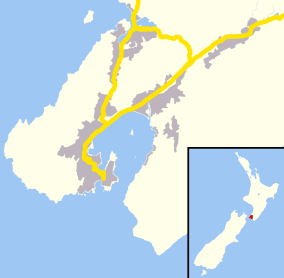Miramar, New Zealand
| Miramar | |
|---|---|
 Miramar | |
| Basic information | |
| Local authority | Wellington City |
| Date established | 1904 |
| Coordinates | 41°19′S 174°49′E / 41.317°S 174.817°ECoordinates: 41°19′S 174°49′E / 41.317°S 174.817°E |
| Population | 8,334 (2006 [1]) |
| Surrounds | |
| North | Maupuia |
| Northeast | Karaka Bay |
| East | Worser Bay |
| Southeast | Seatoun |
| South | Strathmore Park |
| Southwest | Rongotai |
| West | Kilbirnie |
Miramar is a suburb of Wellington, New Zealand, south-east of the city centre. It is on the Miramar Peninsula, directly east of the isthmus of Rongotai, the site of Wellington International Airport.
History
'Miramar' means "sea view" in Spanish. The name was chosen by the first European to settle in the area, Scotsman Coutts Crawford (1817-1889). Crawford was a former Royal Navy officer turned businessman and colonist, who arrived in Wellington in 1840. Crawford established a farm on the peninsula, which at the time was known as Watt's Peninsula, and drained a large lagoon known as Burnham Water. This lagoon covered much of the low-lying land on the peninsula; now this area is occupied by suburban houses, streets, parks and shops.
The original Māori name for the area when it was still an island was Te Motu Kairangi (meaning "esteemed" or "precious" island).[2]
On 18 November 1904 Miramar Borough was formed.[3] In April 1921, Miramar was incorporated into the City of Wellington.[4] The records of the Miramar Borough Council were transferred to the City of Wellington at the time of amalgamation and can still be accessed today through Wellington City Council.[5]
Film
Prior to World War II in 1936 the then government purchased an independent film company called Filmcraft in Darlington Rd, Miramar and set up a full body, government film production operation, to cover New Zealand's contribution in the war (and the 1940 Centennial celebrations). It was called the National Film Unit.[6] In 1979 the NFU moved to Avalon, Lower Hutt, next to the national television entity Avalon Studios. In the late nineties, film director Sir Peter Jackson purchased the Film Unit, as it was then known, to produce his films. He used the NFU's facilities while making Braindead. Since then, Jackson has brought the Film Unit back to Miramar, which would now be seen as a sunset arm of his empire.
Jackson and his colleagues Sir Richard Taylor (VFX) and Jamie Selkirk (Editor) have built a series of multimillion-dollar studios, sound stages, and pre- and post-production facilities in Miramar that include Stone Street Studios, Park Road Post, Weta Digital, and Weta Workshop. Jackson filmed the studio scenes of The Lord of the Rings trilogy and King Kong in Miramar. Miramar has been hailed by Mexican film director Guillermo del Toro as "Hollywood the way God intended it".[7]
Education
There are four primary schools in Miramar - Holy Cross School (Years 1 - 8), Miramar Central School (Years 1 - 6), Miramar Christian School (Years 1 - 8), Miramar North School (Years 1 - 6).
References
- Struthers, John (1975). Miramar Peninsula: A Historical and Social Study. Wellington: John Struthers; Wright & Carman.
- ↑ The population is the aggregate for the census areas of Miramar South (Quickstats about Miramar South) and Miramar North (Quickstats about Miramar North)
- ↑ "Te Motu Kairangi / Miramar Peninsula Place Name Proposal Report". Land Information New Zealand (LINZ) - Toitū te whenua. 3 August 2010. Archived from the original on 6 February 2012. Retrieved 26 February 2012.
- ↑ http://www.wcl.govt.nz/wellington/miramarseatoun.html Wellington City Library
- ↑ Struthers 1975, pp. 60,61.
- ↑ "Archives - Overview - Wellington - New Zealand". Wellington City Council. Retrieved 11 April 2012.
- ↑ Struthers 1975, pp. 85,86.
- ↑ Guillermo del Toro Chats with TORN About ‘The Hobbit’ Films! | Hobbit Movie News and Rumors | TheOneRing.net | The Hobbit and Lord of the Rings Movie News and Rumors